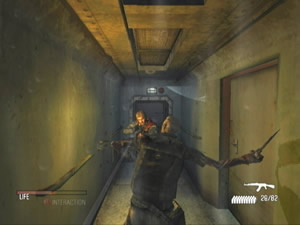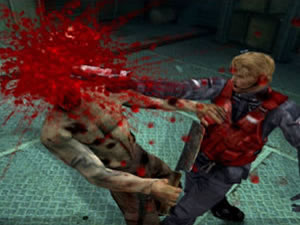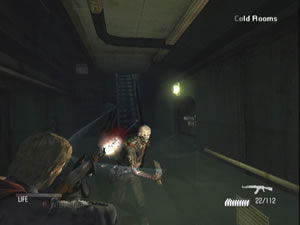A three-hour tour.
Sometimes, the sweetest things in life are brief. Watching a sunset, giving a goodbye kiss, shooting a zombie in the head with a 12-gauge – these fleeting joys come and go like a flickering flame in an autumn breeze. Oh, wait…you paid fifty dollars for that flickering flame? And it lasted how long?
We love sweet games, but for our money, they better outlast a struck match. I mention this because I recently finished Ubisoft’s new Cold Fear about six hours after I started. Cold Fear is a streamlined, uncomplicated, and, yes, very brief foray into survival horror, making it perhaps the best rental and worst buy ever.
You play as Tom Hansen, a coast guard hero who has been ordered to board and explore a Russian whaling ship in the middle of an Arctic storm. As you explore the storm-blasted vessel, you discover a tired plot involving the use of zombies and other mutants as military weapons gone awry (can’t we think of anything else to do with zombies? Stand-up comedy? Telemarketing? Anyone?). Battling zombies and Russians alike, you meet up with the obligatory female, discover a secret underwater lab, and, by the end, save everything from utter ruin.
The most apparent innovation in Cold Fear is the ship itself. Tossing in the arctic tempest, the vessel rolls and sways menacingly beneath your feet. As you scurry around the deck, you must avoid swinging cranes and blasts of water cresting over the side of the ship. These threats are compounded by rain-blurred vision and the unpredictable rocking of the boat. Tom shields his face with his arm when he faces into the wind and stumbles when the boat is shook by a wave. The storm effects are superb, lending a kind of nutty anxiety to a simple walk from one side of the ship to the other. Hope you took your Dramamine.
When you’re not falling off the side of the ship, you’re being attacked by Russians and zombies, and that’s when you really start cursing the storm. Whereas on a sunny day in Raccoon City you might easily de-head a few drooling flesh monkeys, on the ship your aim is wildly unpredictable. Employing the same over-the-shoulder, first-person aiming system as the one in Resident Evil 4, Cold Fear ramps up the difficulty by making both the boat and your aim careen out of control. Grabbing a rail steadies your aim and your footing, but also leaves you stationary in the face of rushing zombies
And rush they will. Seemingly pulling another page out of RE 4‘s book, Cold Fear features lightning-quick zombies and reasonably smart Russian mercenaries. Reanimated flesh “possessed” by small, tendril-like alien creatures, the zombies are nicely rendered, looking appropriately bloodthirsty and dead. Developer Darkworks has taken the traditional zombie – the shambling, moaning figure – and fed him a strictly Wheaties-and-beef diet. The results are swarthy and muscular, possessing rudimentary artificial intelligence and eerily glowing eyes. The Russian mercenaries, on the other hand, behave erratically, call out to each other in Russian, and generally act as paranoid as a smarter Tom Hansen might (locking themselves in rooms, fortifying their positions, and shooting everything that moves).
Killing the zombies requires a head shot every time. Like Silent Hill‘s Harry Mason, Tom steps on a lot of heads. But unlike Silent Hill, the amount of time that a downed zombie takes to recover is just barely the amount of time it takes to dispose of them the Nike way. They get up like the dickens, too, and that makes almost every encounter a close call.
In many of the early levels, Tom will open a door to discover the scene of an ongoing firefight between Russians and zombies. Whether you choose to join in or sit and watch, the winners always turn their attention your way at the end. These fights, and other scenes in which Tom seems to interrupt an ongoing story, give a nice immersive feel to the game.
 Indeed, Darkworks has tweaked a few of the survival-horror conventions in an attempt at a more immersive experience. One is the absence of any inventory or status menu. Weapon changes are made on the fly and health packs and ammo are acquired by searching dead corpses, but there is no way to stockpile. What each corpse carries seems to be directed by what Tom needs most. If he’s out of pistol ammo, he’ll find pistol ammo. If he’s wheezing his last breath, he’ll get a health pack. Although it might sound a bit cheesy, it’s implemented nicely and gets rid of the frequent pauses that mar most action-based survival horror games.
Indeed, Darkworks has tweaked a few of the survival-horror conventions in an attempt at a more immersive experience. One is the absence of any inventory or status menu. Weapon changes are made on the fly and health packs and ammo are acquired by searching dead corpses, but there is no way to stockpile. What each corpse carries seems to be directed by what Tom needs most. If he’s out of pistol ammo, he’ll find pistol ammo. If he’s wheezing his last breath, he’ll get a health pack. Although it might sound a bit cheesy, it’s implemented nicely and gets rid of the frequent pauses that mar most action-based survival horror games.
However, Cold Fear also does away with any kind of in-game map. Navigation, therefore, relies on memory and a keen sense of translation. When the mission menu tells you to go to the “Magnetic Control Room,” you should know to go to the room marked by the “Communications Room” sign. Huh?
The story-driven save points also lead to some immersive backfire. Only when Tom opens certain doors for the first time will the game allow you to save. While doing away with ink ribbons and such, the placement of the save points are uneven and frustrating. Sometimes you’ll go twenty minutes without a save, but other times you’ll save every twenty seconds.
One convention that Ubisoft doesn’t change, unfortunately, is the dreaded fixed camera that haunts the genre. When not in the over-the-shoulder view, Cold Fear employs static and cinematic camera angles. The age-old problem of pushing the wrong way on the stick when the camera angle changes is as persistent as a zombie with a small head.
To make up for this, Tom can walk and strafe in the over-the-shoulder aiming mode. Most of the game will be spent in this view, which is a good alternative, but unwieldy when dodging attackers. Another plus to the over-the-shoulder view is the flashlight attached to some of the weapons; not only do you aim where you want to shoot, but in some darkened areas, you must aim at what you want to see. Considering some creatures can approach from either floor or ceiling, the foreshortened lighting does a lot to increase tension.
Cold Fear spends many of its spook dollars on environmental effects. Lights flicker and go out at crucial times, hanging kitchen utensils bend and sway to the motion of the ocean appropriately, and gas burners accidentally left on erupt into flame if shot. Even taking out zombies and creatures becomes a largely environmental affair. Try shooting a “bait spear” close to an explosive barrel or blowing off a gas valve in the path of approaching zombies. Cold Fear gives you plenty of ways to kill things.
 Aurally, Cold Fear won’t win any Grammy awards. Although the background music is certainly dramatic, it’s too heavy at times, serving you action when you really wanted suspense. The voice-acting parallels the plot; it’s bad but nothing you haven’t heard before. The Russian accents might be a little overplayed, but then again, you can play the game in either French or Spanish and that clears up the vocal work…assuming, of course, that you don’t understand a word of either French or Spanish.
Aurally, Cold Fear won’t win any Grammy awards. Although the background music is certainly dramatic, it’s too heavy at times, serving you action when you really wanted suspense. The voice-acting parallels the plot; it’s bad but nothing you haven’t heard before. The Russian accents might be a little overplayed, but then again, you can play the game in either French or Spanish and that clears up the vocal work…assuming, of course, that you don’t understand a word of either French or Spanish.
With so much attention paid to the environments, Darkworks almost made a great game. Unfortunately, it’s only half a great game. Clocking in at around 6 hours, it might be the shortest adventure-horror game out there and has almost zero replay value. The story is not one that you would care to hear or see again; the CGI cutscenes look and sound worse than the actual gameplay. The ending as well as many portions along the way feel rushed. More than once Tom will enter a well-rendered room that has no purpose in the game at all. Considering much of the game is spent crossing and re-crossing the same boat (and later oil rig/secret complex), you would think that the designers would take advantage of every space they had.
But those empty, ghostlike rooms go unrealized, and the game itself, although promising, is nipped by the cold and bitter wind of a rushed production and a breezy plot. Calling Cold Fear a bad game would be an injustice to all it gets right, so instead, we deem it a great rental, which accurately captures both its length and its eventual future on the shelves of your local Blockbuster.
-
Environmental physics
-
Very immersive
-
No item menus
-
No map
-
Short, weak story
-
No replay value











